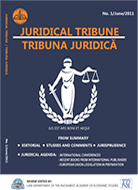Understanding trends in the worst forms of child labour
and the state’s legal responses: a descriptive analysis
Understanding trends in the worst forms of child labour
and the state’s legal responses: a descriptive analysis
Author(s): Mashele RapatsaSubject(s): Law, Constitution, Jurisprudence
Published by: Societatea de Stiinte Juridice si Administrative
Keywords: child exploitation; child well-being; children’s rights; transformation; development;
Summary/Abstract: This article discusses trends in the worst forms of child labour. It also examines state’s legal responses designed to eradicate child economic exploitation. This is premised on the Constitution transformative ideal of accelerating social transformation and human development. The exploitative nature of the worst forms of child labour is amongst the most disconcerting aspects in social, educational and economic realities. Most repugnant forms include children being subjected to Commercial Sexual Exploitation, Children being Used to Commit Illicit Activities, bondage labour and other hazardous economic activities. Suchactivities often result in unalterable physical and psychological harm or even worse, threaten children’s lives. Thus, it is a human rights issue, which infringes children’s core rights such right to dignity, life, social security and freedom. Widespread anecdotal evidence suggests that no country in the world is immune from this scourge, and so is South Africa. Hence, the need to highlight the nature and extent of prevalence, and the efficacy of the rights-based legal instruments adopted against child economic exploitation. It is asserted that factors that proliferates child economic exploitation manifests in the form of primary factors (those with direct impact such as social deprivations, e.g. poverty) and secondary factors (those that relate with action or inaction of governments, e.g. corruption, lack of state capacity). It is argued that legal instruments will be of no effect lest these direct and indirect causes are not interrupted. Widespread awareness campaigns also remain indispensable in order to conscientise society regarding the urgency of the problem.
Journal: Tribuna Juridică
- Issue Year: 7/2017
- Issue No: Special
- Page Range: 186-199
- Page Count: 14
- Language: English

